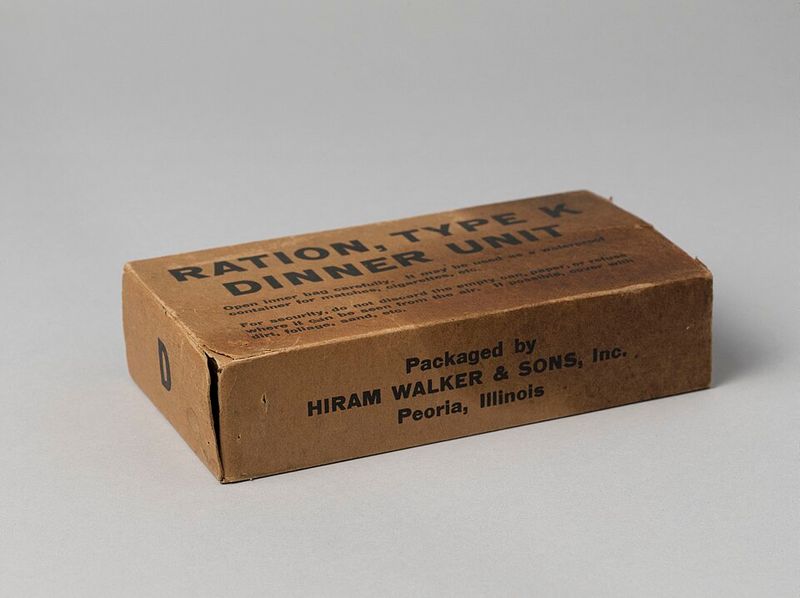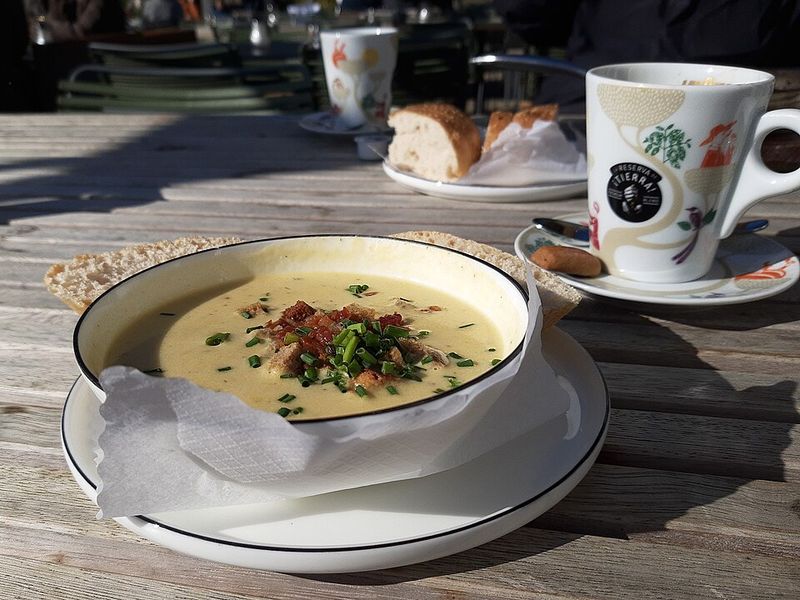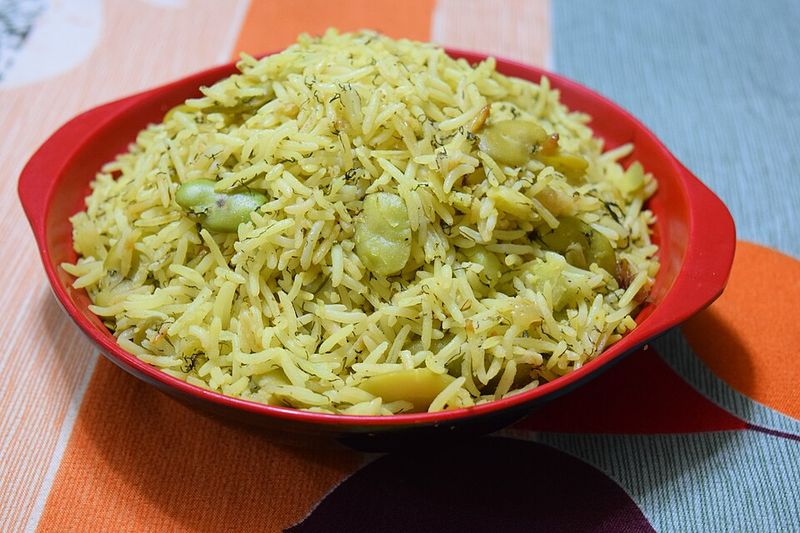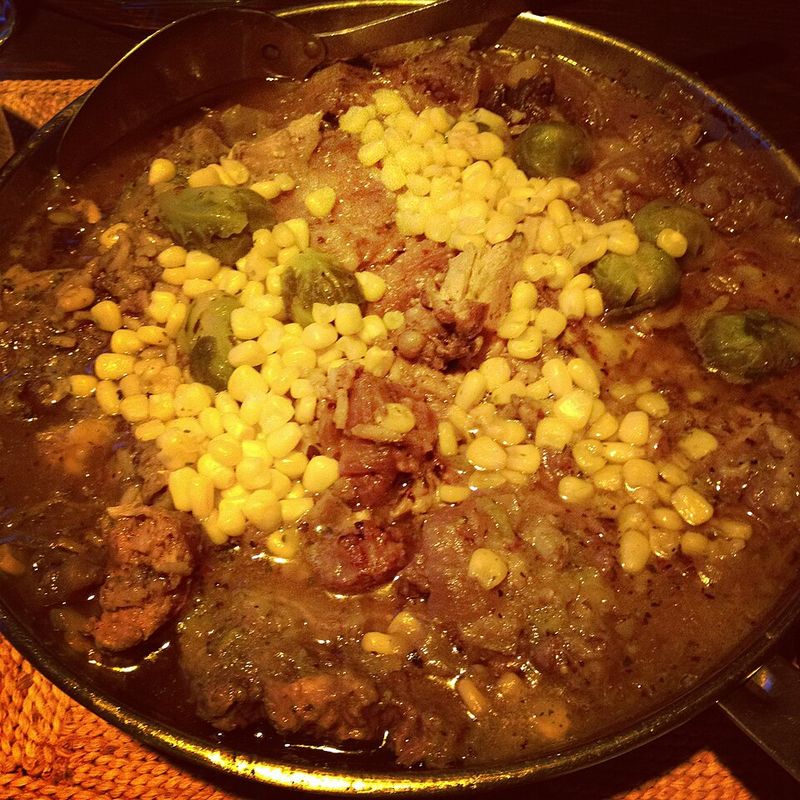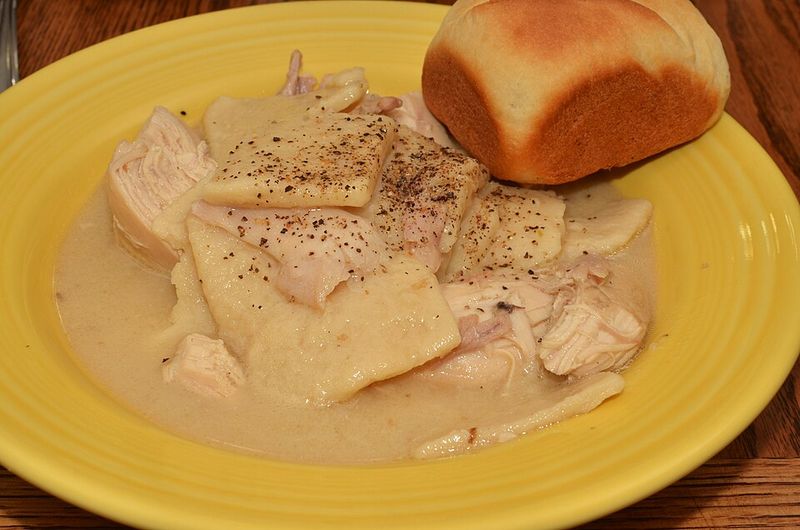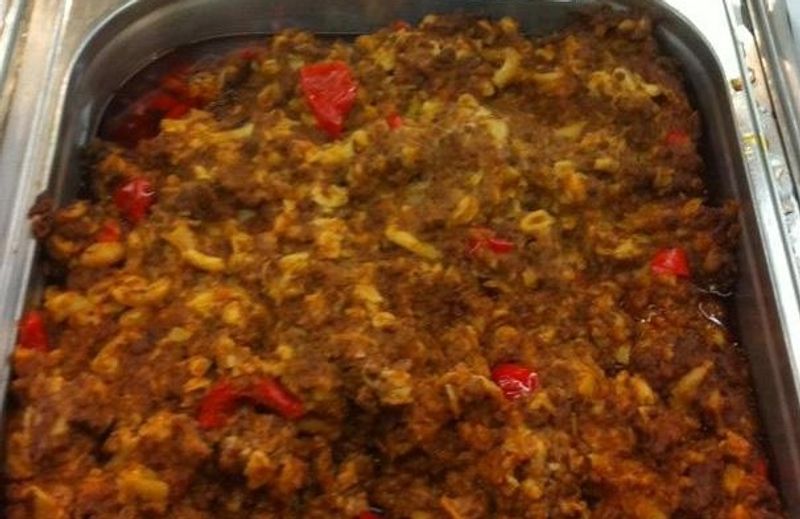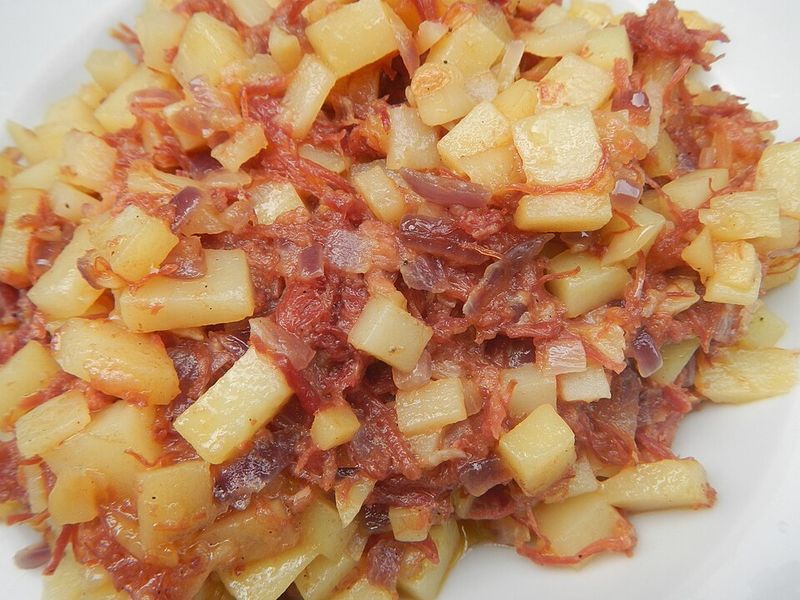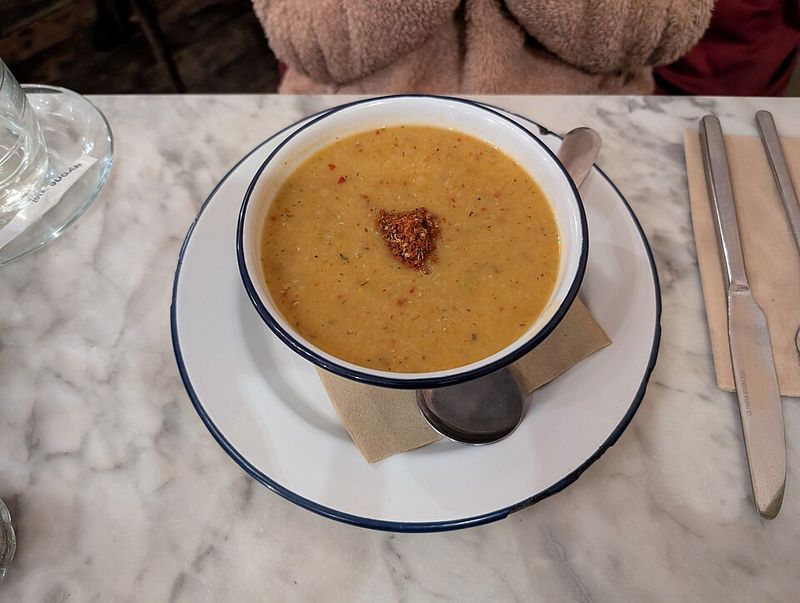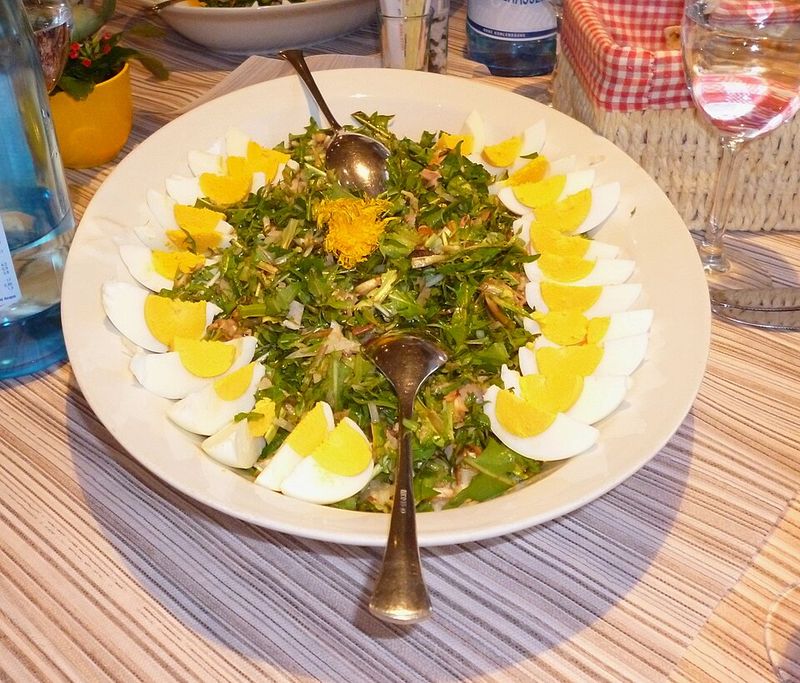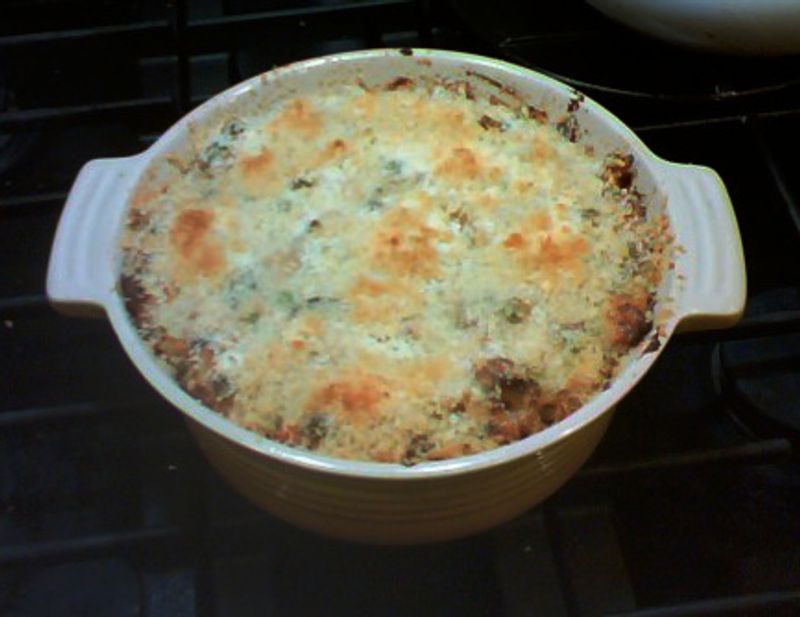When pantry shelves ran low and paychecks ran thinner, Americans turned to ingenuity in the kitchen. These meals weren’t just recipes; they were lifelines, stretching pennies into plates of comfort. From wartime rations to Depression-era desserts, each dish tells a story of resilience and resourcefulness. Read on to discover how humble ingredients came together to nourish families through the toughest chapters in history.
1. Depression Cake
Also called Milkless, Eggless, Butterless Cake, Depression Cake symbolized thrift and ingenuity. Bakers relied on pantry staples – flour, sugar, spices, and dried fruit like raisins or prunes—activated with vinegar and baking soda instead of expensive eggs and butter. Apples or pears often added moisture and sweetness, cutting the need for dairy. Families baked it for birthdays and gatherings, preserving tradition despite scarcity. Spices like cinnamon and clove created a comforting aroma that uplifted spirits. The cake’s longevity made it perfect for rationed kitchens, staying moist for days. Today, it endures as a testament to resilient, joyful baking under pressure.
2. K-Ration
Designed for American soldiers in World War II, the K-ration compressed calories, convenience, and morale into a portable box. Each meal unit—breakfast, dinner, or supper – contained components like canned meat, biscuits, a chocolate bar, powdered drink, and sometimes cigarettes. Nutrition wasn’t perfect, but it kept the troops moving when kitchens weren’t possible. Lightweight and shelf-stable, it offered predictable sustenance in unpredictable conditions. Back home, its practicality influenced civilian emergency reserves and lunchbox ideas. The K-ration demonstrated how logistical innovation could feed millions under extreme constraints. Its legacy survives in modern field rations and emergency kits.
3. Potato Soup
Potato soup was a frugal, filling staple that turned a few tubers into a nourishing pot. Onions, water or broth, and a handful of herbs delivered depth, while a bit of milk or bacon fat – when available – enriched the texture. Families could bulk it up with carrots, celery, or leftover ham bones. Served with bread heels, it stretched to feed many. The soup reheated well, making it efficient for busy, cash-strapped households. Each bowl offered warmth and stability during uncertain times. Even today, its minimalist ingredient list and soothing flavor speak to economy without sacrificing comfort.
4. Rice and Beans
Rice and beans sustained families with complete protein at a low cost, crossing regional lines to become a national standby. Dry beans soaked overnight and simmered until tender paired with rice for bulk and energy. Spices, onions, or ham hocks elevated flavor when budgets allowed. Leftovers transformed into burritos, casseroles, or fried rice, limiting waste. Nutritionally robust and endlessly adaptable, this duo anchored many weeknight meals. In hard times, it offered reliability and satiety. Communities shared techniques to maximize flavor, teaching generations frugality and nourishment in the same bowl. Its versatility ensured enduring popularity.
5. Cornbread and Buttermilk
In Southern kitchens, a bowl of crumbled cornbread soaked in chilled buttermilk made a thrifty, cooling supper. Cornmeal kept costs down, while buttermilk provided tang and a touch of protein. Salt, baking powder, and hot fat created a crusty, aromatic slice. When produce was sparse, this combination still satisfied. Some added sliced onions or a drizzle of sorghum for complexity. Quick to assemble and gentle on resources, it filled late-night hunger or stood in for lunch. The dish embodies resourceful simplicity—nothing wasted, everything useful. It remains an enduring comfort during lean seasons and hot summers.
6. Red Beans and Rice (Monday Washday)
New Orleans households traditionally simmered red beans on Mondays, letting the pot bubble while laundry chores consumed the day. Dried beans cooked slowly with onions, celery, bell pepper, bay leaves, and a ham bone or sausage when available. Over rice, the dish yielded creamy comfort that fed many. Seasonings like cayenne and thyme added depth even when meat was scarce. Leftovers improved as flavors melded, ideal for stretched budgets. This rhythm built community and predictability during hard times. Red beans and rice exemplify thrifty planning: a pot that works while you do, nourishing the week ahead.
7. Hobo Stew
Hobo Stew emerged from itinerant camps, where travelers pooled ingredients to create communal nourishment. Potatoes, carrots, onions, and canned tomatoes formed the core, with any scraps of meat or beans added for protein. The pot simmered over open flames, filling the air with camaraderie and spice. It embraced spontaneity—whatever you had went in. Cheap, flexible, and shareable, it represented collective resilience. Each bowl tasted a little different, echoing the day’s fortunes. Even today, the dish inspires community cookouts and charity events, honoring a tradition born from necessity and generosity on the rails and roads.
8. Johnnycakes
Johnnycakes, simple cornmeal griddle breads, predate the nation and persisted through lean eras. Made from cornmeal, water or milk, salt, and fat, they cooked quickly on a hot griddle. Crisp edges and tender centers delivered satisfaction with minimal cost. Topped with a smear of butter or drizzle of molasses, they doubled as breakfast or dinner. In hard times, corn’s affordability made johnnycakes dependable. Their portability suited laborers and travelers. As a symbol of resourceful grains cooking, johnnycakes bridged indigenous techniques and colonial survival, carrying forward into modern comfort food traditions across New England and beyond.
9. Beans on Toast
Beans on toast made a quick, affordable meal when time and money were tight. Cooks warmed stewed beans – homemade or canned – in a lightly seasoned tomato sauce, then ladled them over crisp toast. The starch and protein combo filled stomachs and stretched supplies. A sprinkle of onion, cheddar, or mustard added lift when available. It was easy to scale from one person to a hungry household. Leftover beans morphed into soups or casseroles. This dish’s reliability and minimal cleanup made it a weeknight savior, proving that comfort doesn’t demand complexity or cost to deliver real nourishment.
10. Chicken and Dumplings
Chicken and dumplings transformed modest poultry into a feast by stretching flavor with broth and flour. A whole bird or bones simmered to create rich stock, then carrots, celery, and onions rounded out the stew. Drop dumplings or rolled noodle-like dough poached on the surface, yielding pillowy comfort. Families prized its economy – one chicken fed many bowls. Leftover meat and broth became next-day soup or pot pie. The dish soothed during illness and uncertainty, delivering warmth and calories in equal measure. Its enduring popularity proves that simple techniques can conjure deep, life-affirming satisfaction from humble ingredients.
11. Goulash (American Chop Suey)
American goulash – often called American chop suey – stretched a bit of ground beef across a whole pot of pasta. Onions, garlic, tomatoes, and paprika brought big flavor with small expense. The one-pan method saved fuel and time, crucial in rationing eras. Leftovers packed easily for lunch and reheated beautifully. Families customized with bell peppers or corn depending on pantry luck. It became a church supper and school cafeteria staple, feeding crowds without fuss. Economical, filling, and familiar, goulash served as a weeknight anchor, embodying hard-times practicality blended with crowd-pleasing comfort.
12. Corned Beef Hash
Corned beef hash turned leftovers into a hearty new meal. Diced potatoes and onions crisped in fat, then chopped corned beef joined the skillet for savory, crunchy bites. An egg on top – if available – completed the plate. Born from preservation and rationing, hash maximized every scrap. It fed workers before dawn and families after church, stretching protein while satisfying cravings. The dish’s adaptability made it timeless: fresh herbs when possible, canned meat when not. Hash reminds us that thrift and indulgence can share a pan, producing comfort with every golden, crackling spoonful.
13. Lentil Soup
Lentil soup delivered remarkable nutrition for pennies, making it a mainstay during lean periods. Dried lentils cook quickly without soaking, sparing fuel and time. Aromatics like onion, carrot, and celery infused the pot, while bay leaves and pepper added depth. A spoon of tomato paste or vinegar brightened the finish inexpensively. Protein-rich and fiber-dense, it kept families full and energized. The soup froze or reheated well, fitting tight schedules. With a heel of bread, it became a complete meal. Its enduring appeal lies in reliability: wholesome, adaptable, and consistently satisfying from the first ladle.
14. Peanut Butter and Jelly Sandwich
The PB&J sandwich offered affordable protein and quick energy to generations of schoolchildren and workers. Peanut butter’s shelf stability and satiety paired perfectly with sweet jam to make a balanced bite. During tight budgets, it required no cooking, minimal cleanup, and transported well. Parents stretched loaves to cover a week’s lunches. Variations with bananas or honey kept it interesting. Despite its simplicity, PB&J carries deep cultural memory – lunchboxes, picnics, and after-school snacks. It epitomizes practical nutrition that kids actually eat, sustaining families when time and money are in short supply.
15. Corn Pone
Corn pone, a no-frills cornmeal bread, fed Appalachian families when wheat flour was scarce. Mixed with water, salt, and fat, the dough shaped into hand-formed patties and baked or fried. The result was hearty and portable, ideal with beans or greens. Its simplicity reduced dependence on costly ingredients, while corn’s reliability sustained communities. Pone adapted to the pan you had – skillet, hearthstone, or sheet. Crisp edges and tender centers offered comfort without embellishment. In hard times, corn pone proved that modest staples, wisely prepared, could anchor daily meals with dignity and satisfaction.
16. Dandelion Greens Salad
Foraging dandelion greens turned yards and fields into free produce aisles. Bitter young leaves became vibrant salads, often tempered with warm bacon dressing or a splash of vinegar. When eggs or bits of pork were available, they boosted protein and richness. Families embraced the seasonality, gathering greens after rains. This practice reduced grocery bills and connected people to the land. Even without bacon, onions and potatoes made a satisfying wilted salad. Dandelion greens offered vitamins and resilience in a bowl, proving that resourcefulness – and a keen eye – could transform overlooked plants into nourishing meals.
17. Potato Pancakes (Latkes-Style)
Grated potatoes, onion, egg, and a little flour combined into crisp, satisfying pancakes that stretched ingredients impressively. Families fried them in shallow oil, serving with applesauce or sour cream when available. The technique rescued sprouting potatoes and leftover onions from waste. Latkes-style pancakes crossed cultures and budgets, feeding many with little. They worked as breakfast, dinner, or a snack, and reheated well in the pan. Seasonings stayed simple – salt and pepper – proving thrift doesn’t preclude great flavor. In challenging times, potato pancakes delivered texture, comfort, and much-needed calories from the most humble larder.
18. Tuna Noodle Casserole
Tuna noodle casserole emerged when canned fish and pantry staples met postwar practicality. Egg noodles and peas folded into a creamy sauce – often condensed soup – turned modest ingredients into weeknight comfort. A crunchy topping of breadcrumbs or crushed chips added texture. The dish fed many, traveled well to potlucks, and reheated reliably. It proved that canned protein could feel indulgent on a tight budget. Families appreciated the predictable shopping list and short prep time. Even today, it’s a nostalgic favorite, reminding us that economical cans and carbs can create a beloved, belly-warming bake.


